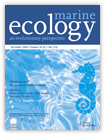Quantitative Benthic Community Structure in Blanca Bay and Its Relationship With Organic Enrichment*
*This paper was read in the Jornadas Nacionales de Ciencias del Mar, September 17–23, 1989. Puerto Madryn, Chubut, Argentina. Contribution Cientifica Dpto. Ciencias Marinas n° 83.
Abstract
Abstract. A two year benthic sampling program of a 2000 km2 area, covering 22 stations, showed a dominance of deposit-feeding polychaetes. The quantitative structure of the three infaunal assemblages was related to a salinity gradient: the inner and outer regions were inhabited by, respectively, mixohaline and euhaline associations, both quantitatively related to granulometric facies of sediment. Species diversity was very low in the inner region, although abundance of opportunistic species was high. In the outer region, abundance and diversity were more stable, with an increasing number of species.
A comparison of species number and abundance with Species-Abundance-Biomass curves from enriched environments showed that the inner region of Bianca Bay may be considered as an organically enriched environment. Scoloplos, a species associated with organic enrichment, and dense terebellid belts were present in great abundances in front of sewage outflows. The spatial distribution of heterotrophic bacteria and the bivalves Corbula and Nucula also followed this pattern.




